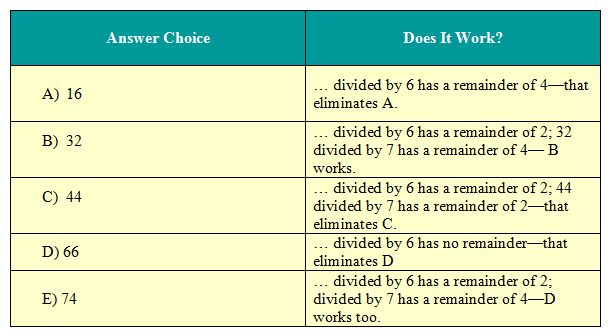24. When to Use the Answer Choices: A Test-Taking Strategy
There are times when plugging in answer choices will help you find an answer faster than solving for a variable on a Quantitative Reasoning question or guessing what kind of words might fit best in the blank spaces on a Text Completion question.
Quantitative Reasoning
You can use the answer choices to help you solve multiple-choice questions with variables.
Here's an example:
Which of the following is a possible value of x?
If x is divided by 6, there will be a remainder of 2. If x is divided by 7, there will be a remainder of 4. What is the value of x?
A) 26
B) 28
C) 30
D) 32
E) 34
The fastest way to solve this problem is by plugging the value of each answer choice into the variable.
Answers: B and D
Text Completion
You may also need to use answer choices to solve Text Completion questions with 2 or 3 blanks.
Here's an example of a sentence in which you would need to use this strategy:
The leaders' ________ relationship was evident when they spent their time _________ each other during the negotiation.
In this sentence, there are no context clues to let us know the nature of this relationship: Were they joking throughout the negotiation, helping each other, ignoring each other--there are no clues!
No matter what, we can see how one part of the sentence relates to the other:
The phrase "was evident when" shows that the second part of the sentence needs to support the statement in the first part of the sentence.

- The word "disheveled" usually has to do with a sloppy or run-down appearance. That might describe a person but not a relationship.
- B and C could both describe relationships, so we need to see if D, E, or F could work with one of them...
- Neither D, E, nor F relate to friendliness, so choice B can be eliminated.
- A contentious relationship describes two people who are prone to fighting one another. While patronizing each other would be annoying, it does not necessarily lead to a fight.
- Choice E, however, would involve slinging insults at one another, and that describes a contentious relationship.
- Finally, choice F would show that these leaders were not too excited to see each other, but that would not prove that they were contentious.
When answering Text Completions, it will save you time if you focus on context clues. If there is not enough information, however, try to see which set of answers work together.
